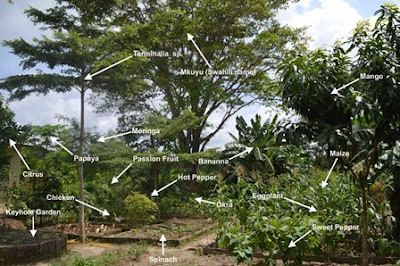PDC LESSON 2.49 DESIGN - HILLS AND FURROWS
PERMACULTURE COURSE AGRO-ECONOMY
PDC LESSON 2.49 DESIGN
- HILLS AND FURROWS
TERASSES ARE ABSOLUTELY NECESSARY
First picture:
In a hilly area it is
necessary to build terraces in the possible width that results from the slope.
These terraces should be designed in such a way that they slope back slightly
towards the slope and then create a furrow there to catch excess water. This is
necessary so that all rainwater, whenever it falls on our hilly garden,
collects on this land and penetrates 100%. It is very important that the thin
upper layer of humus with a thickness of 5 - 10 centimetres remain on our land.
This layer of humus that we painstakingly build up is the capital of our farm.
We must do everything we can not only to improve them, but also to keep them on
our land even in heavy rains.
Third
picture:
But we also need
furrows on level ground, for example for growing potatoes and tomatoes. Both
related plants are the only ones that form new roots to the side of the main
stem as long as that part of the main stem is underground. Tomatoes form a
larger root stem if we keep piling them up to the lower branching first leaf.
The larger the root, the more yield the tomato plant will give.
Potatoes can root up
to a meter high laterally and grow more potatoes from those roots, this is so
often overlooked that's why we grow the potatoes in rows and need a cultivator
that digs a furrow and mounds the soil laterally, and this as a result, we will
constantly renew every few weeks so that the potatoes are always in the ground
as far as possible and we will keep this up until the first flowering or, to
put it another way, we pile up soil and postpone the time until flowering. This
then takes a little longer in the entire growth phase instead of 150, i.e. 180
days, but in the end we have a much higher and larger potato yield.
Second
picture:
In the second picture
on the farm at ground level you can also see that heavy rains, when there are
furrows and these furrows were made beforehand do not wash away the plants. So
before heavy rain comes, we need to channel the water into furrows so that our
crops are protected from the flood. Here, too, the humus remains with the
plants, albeit next to the plants and can then be distributed again with a
cultivator next time. Under no circumstances should we allow the humus to be
washed away by heavy rainfall. This applies to hilly terrain as well as to flat
land.





Comments
Post a Comment